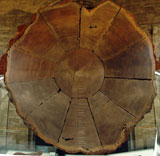Forest fires
Wild fires today affect warm, forested regions of the world on several continents, but they once took place in Britain too.
FAQs
What is a wild fire?
A wild fire, bush fire or forest fire is an uncontrolled fire in a wild habitat.
When a heat wave or drought dries out the plants in an area, a fire can start and spread quickly. Fires can be accidental or they can be caused by arson or even lightning strikes.
Because fires can be very destructive, fire-fighters have developed lots of strategies for extinguishing or controlling wild fire. However, fire can also play an important role in the life cycle of plants and habitats.
Where do wild fires take place?
Wild fires take place all over the world. Major fires happen every few years in the forests of the United States and Indonesia, and in the bush in Australia.
When do they happen?
Forest fires happen mainly in the summer and autumn. They are particularly destructive when there is a drought because branches and twigs die and dry out, creating plenty of fuel for the fire.
How do forest fires spread so quickly?
Wind is a major factor. Some fires spread along the dead leaves and branches at the bottom of trees. Some fires spread when the leafy canopy catches fire. Also, burning leaves and branches can get blown ahead of the main fire causing smaller fires to start.
How can you control a fire?
Planes and helicopters drop water and chemical fire retardant. Fire-fighters create a control line – an area where they remove all the fuel so that the fire can’t travel across it. This can be a barrier like a river or road. They then cut down dead trees to stop them falling across the fire line. Drip torches are used to burn the plants between the control line and the fire to remove the fuel.

Cross-section of the trunk of a giant sequoia tree, Sequoiadendron giganteum
Can fires have positive effects?
In the United States they used to have a policy of putting out all forest fires. However, in the 1960s they realised that there were no new giant sequoia trees growing. They grow in the Western USA and have a larger diameter than any other tree species in the world.
Forest fires are a crucial part of their lifecycle. Fires take warm air up into the tops of the trees, which dries the cones and makes them split, allowing the seeds to pop out.
Fire also clears the undergrowth allowing the seeds to germinate. To allow these processes to continue, the authorities started creating controlled fires and allowing natural fires to burn.
Forest fires in Kent
Museum expert Jerry Hooker studies the geology of Scalers Hill near Cobham in Kent. By looking at the rocks he can uncover the history of this area. The time that interests him most is around 55.5 million years ago when the Earth underwent rapid climate change and global warming.
By studying the charcoal in the area, Jerry and colleagues from Royal Holloway University and The Field Museum, Chicago, have found evidence of regular wild fires in the time leading up to this sudden increase in the earth's temperature.
Their studies also suggest that there were only a few species of plant growing, and these plants may have been well adapted to living in areas with regular fires.
Studying rocks that tell us about past changes in climate can help scientists understand the possible effects of the climate change taking place now.
Meteorite fires
Museum scientist Kieren Howard studies meteorite impacts, which can cause several natural disasters to occur at the same time, including forest fires.
Impacts in southeast Asia
Kieren has studied deposits containing burnt logs in southeast Asia. These are evidence of massive regional forest fires.
The burnt logs are mixed with tektites (glassy stones), which are produced during a very large meteorite or comet impact.
Dating indicates that the fires were started and the deposits were formed at roughly the same time as a meteorite impact.
Scientists do not know exactly where the meteorite hit, but some think the crater may be underwater. Its exact size is unknown and estimates range from 20 to 100km in diameter.
Past meteorite impacts
The K-T Boundary meteorite impact (around 65 million years ago, when many species became extinct) may have been a cause of the extinction of the dinosaurs. It caused massive forest fires and so it showed the link between meteorite impacts and fire.
Much more recently, in 1908, a meteorite exploded over Tunguska in Siberia. This explosion ignited forest fires that were quickly extinguished by the impact’s explosive shock wave.
The Darwin meteorite
Kieren is also studying the origin of the Darwin meteorite crater in Tasmania.
He is interested in finding out about the environmental effects of this event as it occurred in a rainforest wilderness where a meteorite impact is the obvious cause of extensive forest fires.
The challenge lies in finding preserved evidence in the geological record. This can be difficult because half-burnt trees are rarely well preserved. Also, human activities, such as clearing land for farming, and natural processes, such as glaciation, have changed the landscape since the impact. This makes it harder to find the original deposits.
Toolbox

The Museum's smallest members of staff are our flesh-eating beetles, Dermestes maculates, who strip carcasses to the bone.
